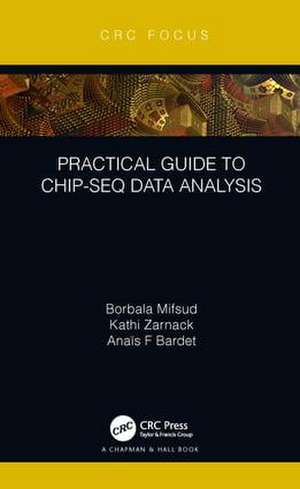Practical Guide to ChIP-seq Data Analysis: Focus Computational Biology Series
Autor Borbala Mifsud, Kathi Zarnack, Anaïs F Bardeten Limba Engleză Hardback – 5 noi 2018
| Toate formatele și edițiile | Preț | Express |
|---|---|---|
| Paperback (1) | 171.68 lei 6-8 săpt. | |
| CRC Press – 13 dec 2021 | 171.68 lei 6-8 săpt. | |
| Hardback (1) | 337.65 lei 6-8 săpt. | |
| CRC Press – 5 noi 2018 | 337.65 lei 6-8 săpt. |
Preț: 337.65 lei
Preț vechi: 437.39 lei
-23% Nou
Puncte Express: 506
Preț estimativ în valută:
64.61€ • 70.40$ • 54.44£
64.61€ • 70.40$ • 54.44£
Carte tipărită la comandă
Livrare economică 23 aprilie-07 mai
Preluare comenzi: 021 569.72.76
Specificații
ISBN-13: 9781138596528
ISBN-10: 1138596523
Pagini: 112
Ilustrații: 3 Tables, black and white; 10 Illustrations, black and white
Dimensiuni: 138 x 216 x 13 mm
Greutate: 0.25 kg
Ediția:1
Editura: CRC Press
Colecția CRC Press
Seria Focus Computational Biology Series
ISBN-10: 1138596523
Pagini: 112
Ilustrații: 3 Tables, black and white; 10 Illustrations, black and white
Dimensiuni: 138 x 216 x 13 mm
Greutate: 0.25 kg
Ediția:1
Editura: CRC Press
Colecția CRC Press
Seria Focus Computational Biology Series
Cuprins
Chapter 1 Introduction to ChIP-seq
Chapter 2 Getting Started
Chapter 3 General Quality Control
Chapter 4 Genomic Alignment
Chapter 5 ChIP-seq-specific Quality Control
Chapter 6 Peak Calling
Chapter 7 Data visualisation
Chapter 8 Comparative Analysis
Chapter 9 Downstream Analyses
Chapter 2 Getting Started
Chapter 3 General Quality Control
Chapter 4 Genomic Alignment
Chapter 5 ChIP-seq-specific Quality Control
Chapter 6 Peak Calling
Chapter 7 Data visualisation
Chapter 8 Comparative Analysis
Chapter 9 Downstream Analyses
Notă biografică
Borbala Mifsud is an assistant professor in Epigenomics at the Hamad Bin Khalifa University, Doha, Qatar. She is a computational biologist with a background in molecular biology and works on 3D chromatin conformation and the integration of epigenomic data.
Kathi Zarnack is a principal investigator in Computational RNA Biology at the Buchmann Institute for Molecular Life Sciences (BMLS), Goethe University Frankfurt, Germany. She is a computational biologist with a background in molecular biology and broad experience in analysing high-throughput sequencing data.
Anaïs F Bardet is a tenured researcher at the National Center for Scientific Research (CNRS) at the University of Strasbourg, France. She is a computational biologist and develops projects exploring the regulation of transcription factor binding.
Kathi Zarnack is a principal investigator in Computational RNA Biology at the Buchmann Institute for Molecular Life Sciences (BMLS), Goethe University Frankfurt, Germany. She is a computational biologist with a background in molecular biology and broad experience in analysing high-throughput sequencing data.
Anaïs F Bardet is a tenured researcher at the National Center for Scientific Research (CNRS) at the University of Strasbourg, France. She is a computational biologist and develops projects exploring the regulation of transcription factor binding.
Recenzii
I found the book to be very well structured; the topic is presented following a logical progression, guiding the reader through a ChIP-seq experiment, illustrating each step of the analytical workflow. The workflow is nicely divided in smaller blocks, each including the relevant theory and practical exercises (consisting of code) that enable the reader to put the theory intro practice, plus suggestions for additional reading.
I particularly appreciated the reference to biases and important issues that need to be considered when planning an experiment, as well as the discussion of data quality issues, extremely relevant to users dealing with publicly available data.
This will be a great resource for teaching, particularly given the use of public data as well as open source software. All that is presented in the book is reproducible, making it an extremely useful resource for any learner. I also appreciated the chapter dedicated to downstream analysis and interpretation – great to see as extremely useful and not often covered to the extent required; similar observation for the integration with other data types, a very timely subject of great interest to many researchers working with different data types and in need of combining the results of different experiment types. This book will be useful to different audiences (experimentalists as well as bioinformaticians) and it is written in a way which is easy to understand for non-technical audiences.
-Gabriella Rustici, University of Cambridge
I particularly appreciated the reference to biases and important issues that need to be considered when planning an experiment, as well as the discussion of data quality issues, extremely relevant to users dealing with publicly available data.
This will be a great resource for teaching, particularly given the use of public data as well as open source software. All that is presented in the book is reproducible, making it an extremely useful resource for any learner. I also appreciated the chapter dedicated to downstream analysis and interpretation – great to see as extremely useful and not often covered to the extent required; similar observation for the integration with other data types, a very timely subject of great interest to many researchers working with different data types and in need of combining the results of different experiment types. This book will be useful to different audiences (experimentalists as well as bioinformaticians) and it is written in a way which is easy to understand for non-technical audiences.
-Gabriella Rustici, University of Cambridge
Descriere
Chromatin immunoprecipitation sequencing (ChIP-seq) is amongst the most widely used methods in molecular biology. This practical book guides experimental biologists and bioinformaticians through the points one needs to consider when designing such a study and the analysis steps from quality control to visualisation.


